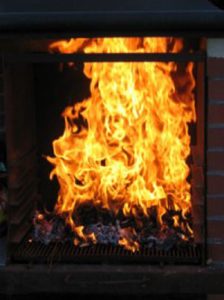We offer a full chimney sweeping service we use both Brush and Vacuum (no mess)
When you book with us we offer a prompt and efficient service.
We clean chimneys from both open fires and stoves.
Chimney sweeping is done to remove build-up of soot and prevent chimney fires and unclog the chimney to stop smoke backing up.
There is no acceptable method of cleaning a chimney using a vacuum cleaner only.
Book us now on 0876307424 or 02229299
or murraycleaningjim@gmail.com
THE CHIMNEY FIRE!!!
Few flues are stout enough to come through a severe chimney fire unscathed. There is no such thing as a “friendly” chimney fire that will safely clean out your flue. With a roar like a freight train, it can crack open flue liner and chimney and spread to the structure of the house.
“Flue fires are perennial”. They happen every winter when creosote deposits on the smoke chamber and flue walls are set ablaze by high heat or by flames licking up the chimney.
A chimney fire can be exciting and light up the night, but it is NEVER a laughing matter. Here’s how it happens and why it can threaten your life and your property.
Anatomy of a flue fire
Heated wood releases hydrocarbon gases. When these get hot enough (about 1100 degrees F) they mix with air and catch fire. When hearth or woodstove fires smoulder, unburned gases condense and deposit on the stovepipes and the flue as runny acids and liquid tars that harden into creosote.
Both a cool flue and steam from green or wet wood encourage this condensation.
Creosote can appear as any of the following;
- a sooty powder
- a gummy mess
- a hard glaze
- or a deposit that looks like burnt marshmallows.
A creosote fire can burn with such blast-furnace intensity that it sets off this frightening chain of events: “Crumbling and cracking mortar; Balls of flaming creosote shoot out of the chimney top onto the roof; Clay-tile flue liners crack open; Stainless steel liners warp, buckle and separate at the seams; Masonry in the chimney expands with such force that sections of the chimney can blow out; flames can spread to the structure or roof of the house even explode into the room”.
Tar-glazed Creosote
This type of creosote makes for the hottest burning fuel for a flue fire. The thicker the layer of creosote, the hotter the fire. The heat generated by this infernal can raise to ignition point, the temperature of wood structures on the other side of a chimney, so that it also starts to burn threatening the entire house.
Wood doesn’t necessarily need contact with fire in order to ignite. It just needs “air, oxygen and enough heat.”
A house may survive the first chimney fire, but the intense heat has started pyrolyzing* nearby combustibles, thus lowering their ignition temperature. This makes the structure very vulnerable to a subsequent chimney fire.
A damaged flue liner can no longer protect either the chimney or the house. And instead of being all burned out, creosote may instead be all puffed up to the point of partially or completely blocking the flue.
What is **Pyrolysis
*Pyrolysis is chemical decomposition caused by heat. Severely pyrolyzed wood can ignite at only 2l2 degrees F, while it would normally have a catch-fire temperature of about 500 degrees F, before it had any exposure to intense heat.
FIRE IN YOUR CHIMNEY!!
If it happens to your chimney get everyone out of the house, because fire can flash right through the house with incredible speed. Then call the fire Brigade from a safe distance such as a neighbour’s house. Do not try to put out the fire and do not hesitate leave immediately.
Reprinted from the March 1998 issue of SNEWS, The Chimney Sweep News, an independent trade magazine for chimney service professionals; P.O. Box 98, Wilmore, KY 40390. Jay Hensley, editor/publisher.
